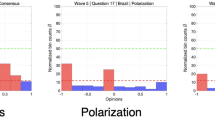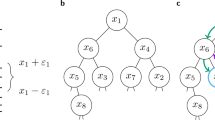Abstract
This paper gives game-theoretic versions of several results on “merging of opinions” obtained in measure-theoretic probability and algorithmic randomness theory. An advantage of the game-theoretic versions over the measure-theoretic results is that they are pointwise, their advantage over the algorithmic randomness results is that they are non-asymptotic, but the most important advantage over both is that they are very constructive, giving explicit and efficient strategies for players in a game of prediction.
Similar content being viewed by others
References
Amari, S., Nagaoka, H. (2000). Methods of information geometry. Providence, RI: American Mathematical Society. Japanese original (1993):
 Tokyo: Iwanami Shoten.
Tokyo: Iwanami Shoten.Blackwell D., Dubins L. (1962). Merging of opinions with increasing information. Annals of Mathematical Statistics 33, 882–886
Dawid A.P. (1984). Statistical theory: the prequential approach. Journal of the Royal Statistical Society A 147, 278–292
Dawid A.P. (1985). Calibration-based empirical probability (with discussion). Annals of Statistics 13, 1251–1285
Dawid A.P. (2004). Probability, causality and the empirical world: a Bayes–de Finetti–Popper–Borel synthesis. Statistical Science 19, 44–57
Dawid A.P., Vovk V. (1999). Prequential probability: principles and properties. Bernoulli 5, 125–162
Feldman J. (1958). Equivalence and perpendicularity of Gaussian measures. Pacific Journal of Mathematics 8, 699–708
Fujiwara, A. (2007). Randomness criteria in terms of α-divergences. IEEE Transactions on Information Theory (accepted for publication).
Greenwood P.E., Shiryaev A.N. (1985). Contiguity and the statistical invariance principle. New York, Gordon & Breach
Hájek J. (1958). On a property of normal distribution of an arbitrary stochastic process (in Russian). Czechoslovak Mathematical Journal 8, 610–618
Jacod J., Shiryaev A.N. (2003). Limit theorems for stochastic processes (2nd ed.). Berlin, Springer
Kabanov, Y.M., Liptser, R.S., Shiryaev, A.N. (1977). On the question of absolute continuity and singularity of probability measures. Mathematics of the USSR—Sbornik, 33, 203–221. Russian original:
 , 104, 227–247.
, 104, 227–247.Kakutani S. (1948). On equivalence of infinite product measures. Annals of Mathematics 49, 214–224
Kumon M., Takemura A., Takeuchi K. (2007). Game-theoretic versions of strong law of large numbers for unbounded variables. Stochastics 79, 449–468
Pukelsheim F. (1986). Predictable criteria for absolute continuity and singularity of two probability measures. Statistics and Decisions 4, 227–236
Rényi, A. (1961). On measures of information and entropy. In Proceedings of the fourth Berkeley symposium on mathematical statistics and probability (Vol. 1, pp. 547–561). Berkeley, CA: University of California Press.
Shafer, G., Vovk, V. (2001). Probability and finance: it’s only a game! New York: Wiley. Abridged Japanese translation (2006):
 Tokyo: Iwanami Shoten.
Tokyo: Iwanami Shoten.Shiryaev, A. N. (1996). Probability (2nd ed.). New York: Springer. Third Russian edition published in 2004.
Solomonoff R.J. (1978). Complexity-based induction systems: comparisons and convergence theorems. IEEE Transactions on Information Theory IT-24, 422–432
Ville J. (1939). Etude critique de la notion de collectif. Paris, Gauthier-Villars
Vovk, V. (1987a). On a randomness criterion. Soviet Mathematics Doklady, 35, 656–660. Russian original:
 , 294(6), 1298–1302.
, 294(6), 1298–1302.Vovk, V. (1987b). The law of the iterated logarithm for random Kolmogorov, or chaotic, sequences. Theory of Probability and its Applications, 32, 413–425. Russian original:
 , 32(3), 456–468.
, 32(3), 456–468.Vovk, V. (1989). Prediction of stochastic sequences. Problems of Information Transmission, 25, 285–296. Russian original:
 , 25(4), 35–49.
, 25(4), 35–49.Vovk V. (1993). A logic of probability, with application to the foundations of statistics (with discussion). Journal of the Royal Statistical Society B 55, 317–351
Author information
Authors and Affiliations
Corresponding author
Additional information
This work was partially supported by EPSRC (grant EP/F002998/1), MRC (grant G0301107), and the Cyprus Research Promotion Foundation.
About this article
Cite this article
Vovk, V. Merging of opinions in game-theoretic probability. Ann Inst Stat Math 61, 969–993 (2009). https://doi.org/10.1007/s10463-007-0165-x
Received:
Revised:
Published:
Issue Date:
DOI: https://doi.org/10.1007/s10463-007-0165-x





 Tokyo: Iwanami Shoten.
Tokyo: Iwanami Shoten. , 104, 227–247.
, 104, 227–247. Tokyo: Iwanami Shoten.
Tokyo: Iwanami Shoten. , 294(6), 1298–1302.
, 294(6), 1298–1302. , 32(3), 456–468.
, 32(3), 456–468. , 25(4), 35–49.
, 25(4), 35–49.